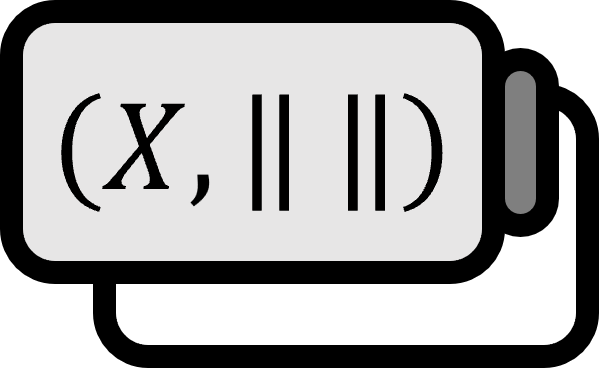Natural Embeddings and Reflexive Spaces
Definition1
Let us call $\left( X, \left\| \cdot \right\|_{X} \right)$ a normed space. And let us define $X^{\ast \ast}=(X^{\ast})^{\ast}$ as the bidual of $X$. Define the function $J : X \to X^{\ast \ast}$ as follows.
$$ J(x)=J_{x},\quad x\in X $$
Here, $J_{x} \in X^{\ast \ast}$ is specifically given as follows.
$$ J_{x} : X^{\ast} \to \mathbb{C} \quad \text{and} \quad J_{x}(x^{\ast})=x^{\ast}(x) $$
In this case, $J$ becomes an embedding. Such $J$ is called a natural embedding or natural injection.
Explanation
Given a normed space $X$, naturally $X^{\ast \ast}$ is provided, and there exists an embedding from $X$ to $X^{\ast \ast}$. For this reason, $J$ is called a natural embedding.
Proof
Since $J_{x}$ is an element of $X^{\ast \ast}$, it is a linear functional of $X^{\ast}$. In other words,
$$ J_{x} : X^{\ast} \to \mathbb{C} $$
Let the linear functional $J_{x}$ of $X^{\ast}$ be defined as follows.
$$ J_{x}(x^{\ast})=x^{\ast}(x),\quad x^{\ast} \in X^{\ast} $$
“The mapping of $J_{x}$ corresponding from $x$ by the mapping $J$” maps $x^{\ast}$ to $x^{\ast}(x)$. It is easy to show that $J_{x}$ is linear.
$$ \begin{align*} J_{x}(x^{\ast} + \alpha y^{\ast}) &= (x^{\ast} + \alpha y^{\ast})(x) \\ &= x^{\ast}(x) + \alpha y^{\ast}(x) \\ &= J_{x}(x^{\ast}) + \alpha J_{x}(y^{\ast}) \end{align*} $$
And the following equation holds.
$$ \begin{align*} |J_{x}(x^{\ast}) | =&\ | x^{\ast}(x)| \\ =&\ \left| \|x\|_{X} \frac{1}{\|x\|_{X}} x^{\ast}(x) \right| \\ =&\ \|x\|_{X} \left| x^{\ast}\left( \frac{x}{\|x\|_{X}} \right) \right| \\ \le & \| x \|_{X} \| x^{\ast} \|_{X^{\ast}} \end{align*} $$
In the third line, since $\|x\|_{X}$ is a constant, it can come out of the absolute value, and since $x^{\ast}$ is linear, $\frac{1}{\|x\|}_{X}$ goes inside the function. Also, the fourth line is $\left\| \frac{x}{\|x\|_{X}} \right\|_{X} = \frac{1}{\left\| x \right\|_{X}} \left\| x \right\|_{X} = 1$ and it holds because the definition of the dual norm is as follows.
$$ \| x^{\ast} \|_{X^{\ast}} = \sup \limits_{\substack{ \| x \|_{X} = 1 \\ x\in X}} |x^{\ast}(x)| $$
Therefore, it holds. From the results above, if we calculate the norm of $J_{x}$,
$$ \begin{align*} \| J_{x}||_{X^{\ast \ast}} =&\ \sup \limits_{\substack{ \|x^{\ast}\|_{X^{\ast}} = 1 \\ x^{\ast} \in X^{\ast}}} | J_{x}(x^{\ast})| \\ \le & \sup \limits_{\substack{\|x^{\ast}\|_{X^{\ast}} = 1 \\ x^{\ast} \in X^{\ast}}} \|x\|_{X} \|x^{\ast}\|_{X^{\ast}} \end{align*} $$
Therefore,
$$ \begin{equation} \|J_{x} \|_{X^{\ast \ast}} \le \|x\|_{X} \end{equation} $$
Let $(X, \left\| \cdot \right\|_{X})$ be a normed space. Let’s call it $Y \subset X$. And suppose a linear functional $y^{\ast} \in Y^{\ast}$ of $Y$ is given. Then, there exists a linear functional $x^{\ast} \in X^{\ast}$ of $X$ that satisfies the equation below.
$$ x^{\ast}(y)=y^{\ast}(y),\quad \forall y \in Y \\[1em] \| x^{\ast}\|_{X^{\ast}} = \| y^{\ast}\|_{Y^{\ast}} $$
Now, let’s call it $X_{1} = \left\{ x \in X : \left\| x \right\|_{X}=1 \right\}$. Then, $X_{1} \subset X$, and by the Hahn-Banach Extension Theorem, there exists a linear functional $w^{\ast} \in X^{\ast}$ of $X$ for $\left\| \cdot \right\|_{X_{1}} \in (X_{1})^{\ast}$ that satisfies the condition below.
$$ w^{\ast}(x_{1}) = \left\| x_{1} \right\|_{X_{1}} = 1,\quad \forall x_{1} \in X_{1} \\[1em] \|w^{\ast}\|_{X^{\ast}} = \left\| \left\| \cdot \right\|_{X_{1}} \right\|_{(X_{1})^{\ast}} = \sup\limits_{\substack{x \in X_{1}}} \left\| x_{1} \right\|_{X_{1}} = 1 $$
Therefore, for any $x \in X$,
$$ w^{\ast}\left( x \right) = w^{\ast}\left(\left\| x \right\|_{X} \frac{x}{\left\| x \right\|_{X}}\right) = \left\| x \right\|_{X} w^{\ast} \left( \frac{x}{\left\| x \right\|_{X}} \right) = \left\| x \right\|_{X} $$
Combining the results above, the following equation holds.
$$ \|J_{x}\|_{X^{\ast \ast}} = \sup \limits_{\substack{\|x^{\ast}\| = 1 \\ x^{\ast}\in X^{\ast}}} |J_{x}(x^{\ast})| \ge |J_{x}(w^{\ast})|=|w^{\ast}(x)|=\|x\|_{X}, \quad x \in X $$
Therefore, as written in the result $(1)$,
$$ \|x\|_{X} \le \|J_{x}\|_{X^{\ast \ast}} \le \|x\|_{X} $$
Therefore, $\|x\|_{X} = \|J_{x}\|_{X^{\ast \ast}}$. That is, $J$ is an isometric mapping. Since an isometric mapping is an embedding, $J$ becomes an embedding from $X$ to $X^{\ast \ast}$.
■
Definition
When it comes to the natural embedding $J$, if $J(X)=X^{\ast \ast}$, i.e., if $J$ is bijective, then the normed space $X$ is called reflexive.
Explanation
To easily rewrite about the embedding again, it is as follows.
Let $X$ be a normed space. In this case, if the following conditions are satisfied for $x\in X$, $x^{\ast \ast} \in X^{\ast \ast}$, then $X$ is called reflective.
$$ \| x \|_{X} = \| x^{\ast \ast} \|_{X^{\ast \ast}} $$
The existence of embedding for $X$ and its bidual means $X \cong J(X) \subset X^{\ast \ast}$. That is, taking the dual of $X$ means that the space becomes progressively larger than $X$ itself. However, if $X$ is a reflective space, taking the dual does not increase its size, and its size is maintained. In other words, even though $X^{\ast \ast}$ may seem different from $X$ outwardly, it is in fact a set with the same structure. Also, a reflective space is always complete. That is, a reflexive normed space is a Banach space.
Robert A. Adams and John J. F. Foutnier, Sobolev Space (2nd Edition, 2003), p6-7 ↩︎
